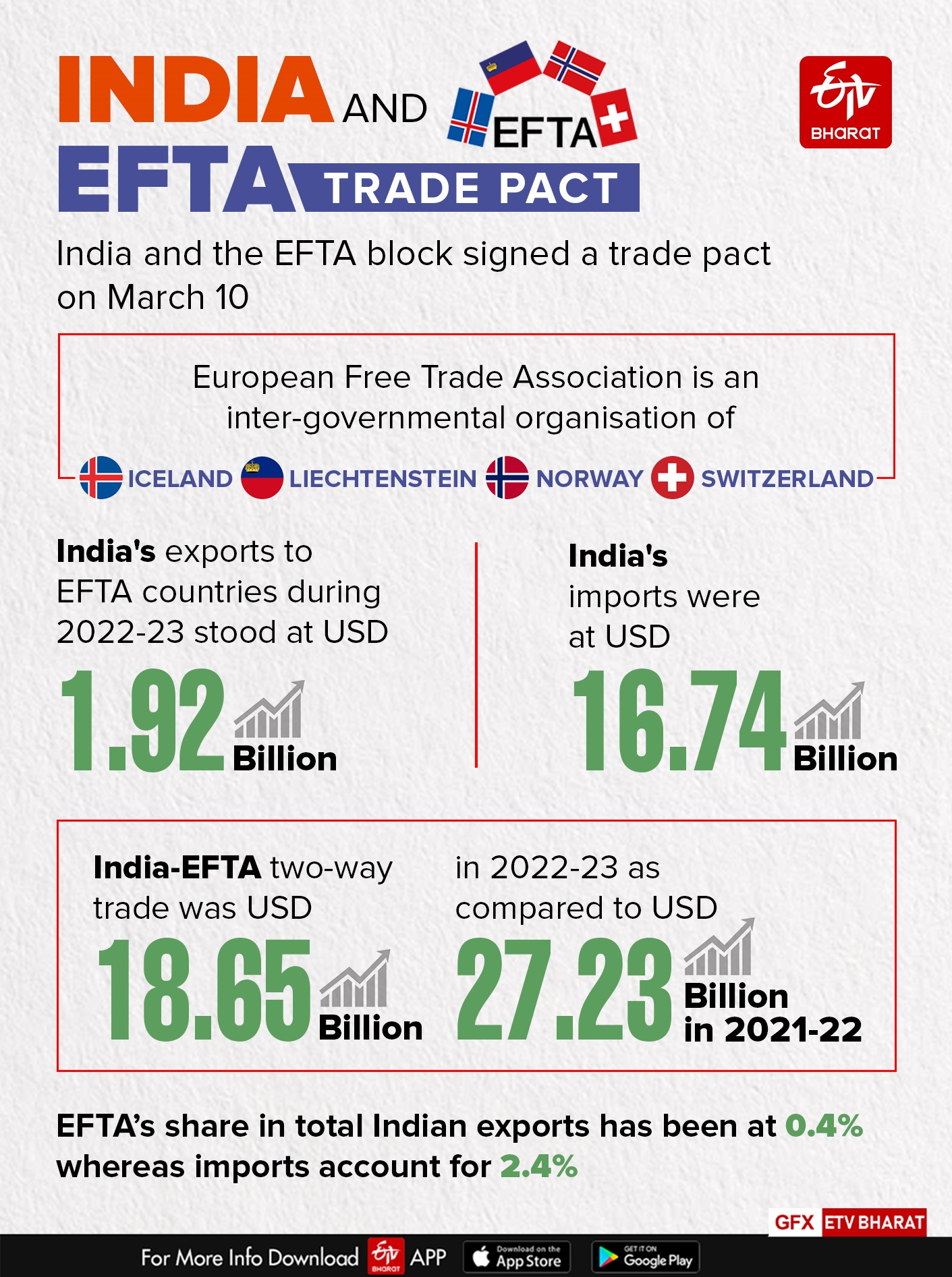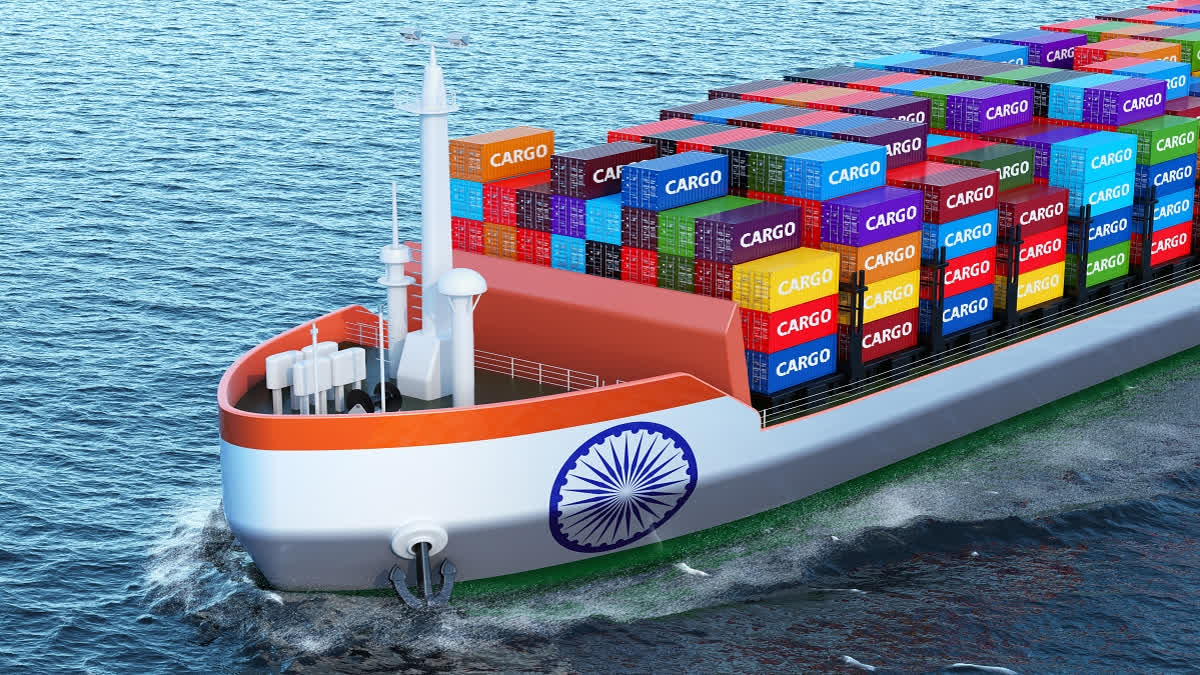India and the 4 nation EFTA block signed a historical trade pact on March 10, 2024. The trade pact presents shared commitment to open fair and equitable trade as well as generating growth and employment for the youth.
During the last 10 years India’s economy had taken a quantum lead as world’s 11th largest economy to the fifth largest economy. The country has been taking a wide ranging reforms, enhanced east of doing business to touch new heights in business, manufacturing and exports.
EFTA (European Free Trade Association) is an inter-governmental organisation of Iceland, Liechtenstein, Norway and Switzerland. EFTA is not a part of European Union. EFTA has so far signed 29 agreements with 40 partner countries including countries like Canada, Chile, China, Mexico & South Korea. India has been negotiating the trade deal with EFTA since 2008.

India's exports to EFTA countries during 2022-23 stood at USD 1.92 billion, while imports were at USD 16.74 billion. India consistently has a trade deficit with the EFTA countries; it peaked at 23.7 billion in 2021-2022 and then declined to USD 14.8 billion during 2022-23 before it again got widened to $ 15.6 USD during April-December 2023.
India-EFTA two-way trade was USD 18.65 billion in 2022-23 as compared to USD 27.23 billion in 2021-22. Major Indian exports to EFTA countries include Chemicals, Semi-Processed stones, boats & ships, Pharmaceuticals and electronic instruments.
India has received about USD 10 billion of foreign direct investments (FDI) from Switzerland between April 2000 and December 2023. It is the 12th largest investor in India. The FDI inflow was USD 721.52 million from Norway, USD 29.26 million from Iceland and USD 105.22 million from Liechtenstein during the period.
EFTA's share in total Indian exports has been at 0.4% whereas imports account for 2.4%. In this context of trade deficit, Indian exporters were extremely cautious in their negotiations. They were aware that duty elimination may lead to a wider trade deficit. The deal is expected to provide duty free EFTA market access to Indian animal products, fish, processed foods, vegetable oils among the other items.
Along with trade aspects India can also look forward for investments in technology transfers in high- tech sectors. The current agreement has 14 chapters including agreement in goods and services trade, rules of origin, Intellectual Property Rights, Investment Promotion and Cooperation, government procurement, technical barriers to trade and trade facilitation.
The agreement with greater market access also has commitment for investment for 100 US$ billion in India over the next 15 years to generate 1 million jobs. The India-EFTA trade deal is likely to unleash opportunities not only in trade and investment, but also for forging strategic partnerships with some of the world's most tech-savvy countries that score very low on corruption and very high on people's quality of life.
Among the EFTA, Switzerland is the largest trading partner of India followed by Norway. Switzerland is considered one of the world's most innovative economies. It had been consistently ranked number one in the Global Innovation Index. The bilateral trade between India and Switzerland stood at USD 17.14 billion (USD 1.34 billion exports and USD 15.79 billion imports) in the last fiscal.
In 2022-23, India's trade deficit with Switzerland was USD 14.45 billion. India's main imports from Switzerland include gold (USD 12.6 billion), machinery (USD 409 million), pharmaceuticals (USD 309 million), coking and steam coal (USD 380 million), optical instruments and orthopaedic appliances (USD 296 million), watches (USD 211.4 million), soybean oil (USD 202 million), and chocolates (USD 7 million).
Major exports from India include chemicals, gems and jewellery, shops and boats, machinery, certain types of textiles and apparel. Switzerland is the largest source of gold imports for India, with about 41 per cent share, the precious metal accounts for over 5 per cent of the India's total imports. Switzerland has some of the major Pharma firms in the world including Novartis and Roche. Both the firms have a presence in India. The two-way trade between India and Norway was USD 1.5 billion in 2022-23.
Under the current EFTA free trade pacts, the two trading partners significantly reduce or eliminate customs duties on the maximum number of goods traded between them, besides easing norms to promote trade in services and investments. India will soon have access to high-quality Swiss products at lower prices because it has decided to remove tariffs on many Swiss goods over seven to ten years.
Key categories of these goods include seafood like tuna and salmon; fruits such as olives and avocados; coffee capsules; different oils like cod liver and olive oil, a variety of sweets and processed foods including chocolate and biscuits. Other products that are covered are smartphones, bicycle parts, medical equipment, clocks, watches, medicines, dyes, textiles, apparel, iron and steel products, and machinery equipment.
The tariffs on cut and polished diamonds will be reduced from 5 per cent to 2.5 per cent in five years after the implementation of the agreement. India has offered no effective tariff concessions on gold. On paper, it has offered a one per cent concession on the bound rate of 40 per cent, but the effective duty remains at 15 per cent, resulting in no real benefit.
For wines, the duty concessions are similar to those given to Australia, with no concessions for wines costing less than USD 5. Wines priced between USD 5 and less than USD 15 will see a duty reduction from 150 per cent to 100 per cent in the first year, then decreasing gradually to 50 per cent over 10 years.
India has been discussing FTAs with several partners both at bilateral and regional level and India-UK FTA had been at an advanced stage. India so far has inked 13 FTA’s with its partners during the last five years, and the most recent once with the Mauritius, UAE and Australia.
In the current India-EFTA FTA agreement 'Agriculture and Dairy Sectors' which are crucial and sensitive for both the sides had been left out. Services and the manufacturing sector would receive a big boost in the coming years, with investments from the EFTA partners. Some of the sectors which would be benefitting from the current 100US billion investments from the EFTA would be farm sector, renewable energy, dyes and chemicals, expensive machinery, the food processing sector and the services sectors which covers large chunk of Indian exports.
EFTA too would be able to diversify its supply chain from current pivot point China and would be able to benefit from the current demographic and skilled labour force of India. Investments would also come from retirement and pension funds in EFTA countries including Norway's, 1.6 $trillion sovereign wealth Fund and 15 $billion Green Technology Investments.
With a world-wide edge in innovation and technology across the divergent fields from digital trade, pharmaceuticals, bio-technology, food processing and chemicals, finance and banking sectors, high-tech farming , supply chain logistics and green technology EFTA countries could back India for achieving cutting edge technological advancement in manufacturing, agriculture and the services sector realising its goal towards 'Self Reliant India'.



